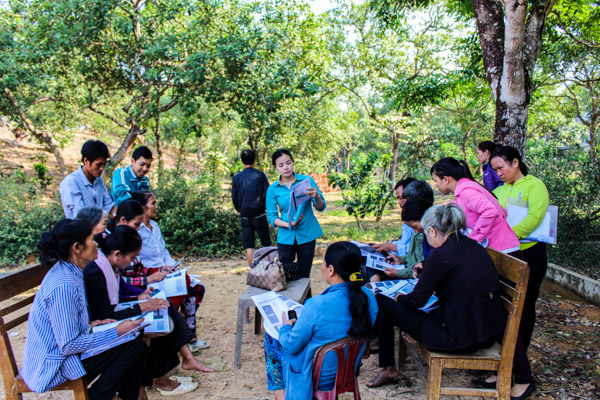
Pulling for Forests in Vietnam
How e-payments make life easier for community-based forest owners
Jennifer Norfolk, Associate Director, Forestry and Natural Resource Management Unit
 The wheels are spinning, but the vehicle is going nowhere. It’s rainy season in Vietnam, and dirt roads have become rivers of mud. It’s not uncommon for a vehicle to become mired in the muck. But in this case, the vehicle holds much-needed funds that won’t be delivered to community-based forest owners unless a team of determined forest fund staff rescues it. It’s a sticky situation — but one that may not happen much longer.
The wheels are spinning, but the vehicle is going nowhere. It’s rainy season in Vietnam, and dirt roads have become rivers of mud. It’s not uncommon for a vehicle to become mired in the muck. But in this case, the vehicle holds much-needed funds that won’t be delivered to community-based forest owners unless a team of determined forest fund staff rescues it. It’s a sticky situation — but one that may not happen much longer.
Changes in Vietnam’s innovative Payment for Forest Environmental Services (PFES) system, implemented by Winrock’s Vietnam Forests and Deltas project, will soon make life much easier for the community-based forest owners who are paid through this program.
Most PFES payments originate from hydroelectric plants and other downstream users of environmental services who need to know they will have a steady stream of low-silt water at their disposal. The Government of Vietnam determined that it’s a better investment to pay for good forest cover proactively rather than dredging reservoirs on a regular basis if the forest is not maintained.
Users pay mandated fees to the Vietnam Forest Fund (VNFF), which distributes these funds to the provincial authorities for further distribution to community-based forest owners. However, to actually get these funds into the hands of people caring for the forests has been a real hardship. Often, members of the provincial-level staff have to ferry bags of cash to remote mountain communities on dirt roads — a costly and inefficient method that is dangerous for everyone involved, especially during the rainy season.

Winrock has been working with VNFF and their provincial funds to find an effective way to transfer this money electronically. Through several pilot initiatives in Lam Dong and Son La provinces, the Vietnam Forests and Deltas project has helped make this arduous task as simple as a few mouse clicks. This means that Nguyen Thanh Long, deputy head of Cat Tien National Park Forest Protection Department in Lam Dong province, can now pull up the data for those requiring payment and transfer funds through an e-payment system managed by Viettel, a Vietnamese telecom provider.
“As Forest Protection Department Fund officers, we are also happy, as we are no longer worried about losing money or taking months to complete the payment process,” Long says.
E-payments are a new way of doing business for members of the community. Most have traditionally engaged in cash transactions, so Winrock’s training on how to do e-payments is crucial. Once over the learning curve, though, people are certainly seeing the benefits of quicker transactions, more transparency in the transfers (both with the government and within the household), and additional access to financial services.

“Local people were very happy when receiving the payment through Viettel Pay before Tet holiday because they received the money much more quickly and were ready for Tet,” Long says. In addition, Viettel e-payment subscribers can access a range of banking services such as savings accounts.
Winrock’s partnership with Viettel and VNFF is making Vietnam’s pioneering PFES system more efficient and transparent. The rains will still fall, the roads will still flood. But with easy and predictable transactions, all parties will have more trust in a system that is currently creating $125 million per year for forest conservation.
Related Projects

